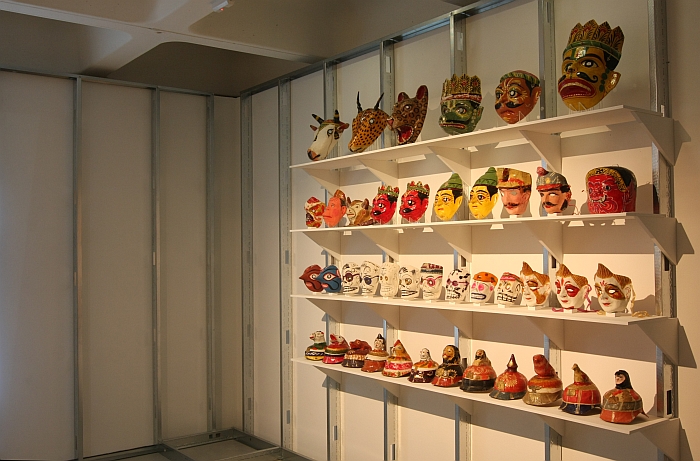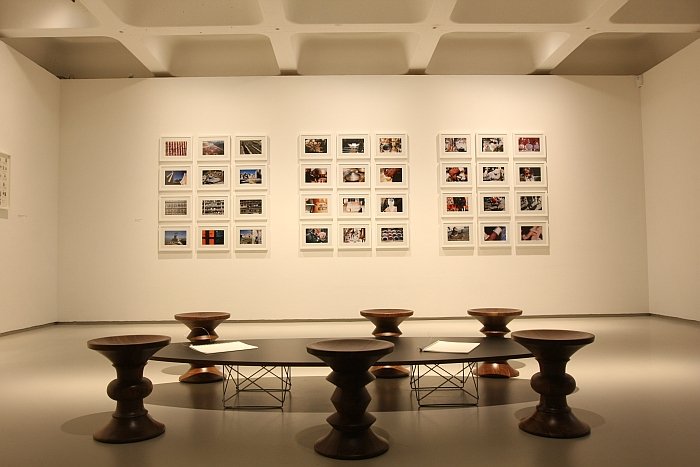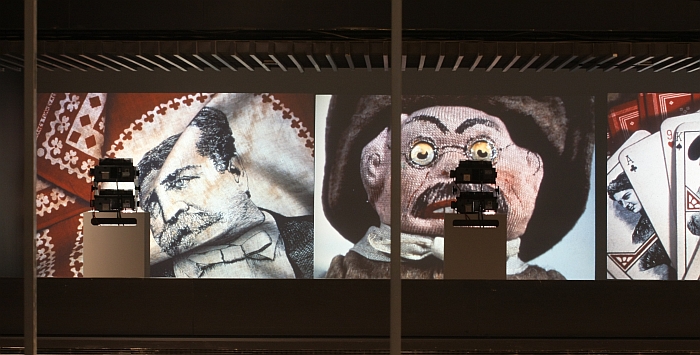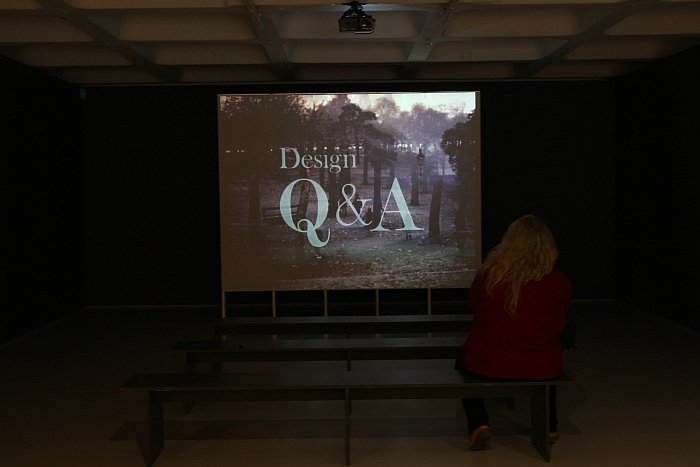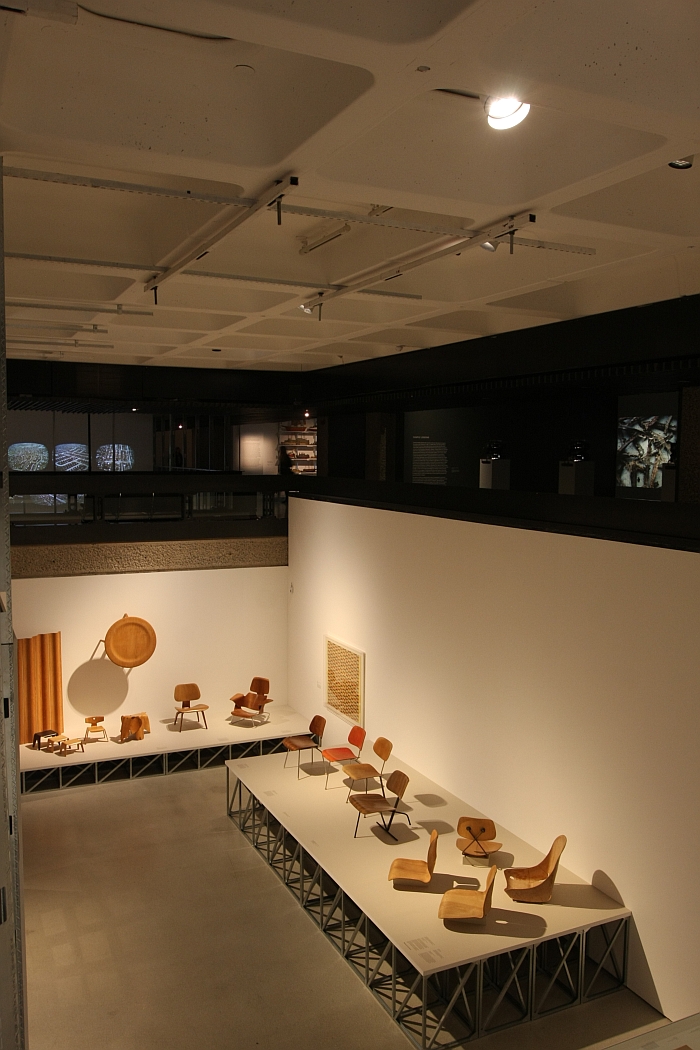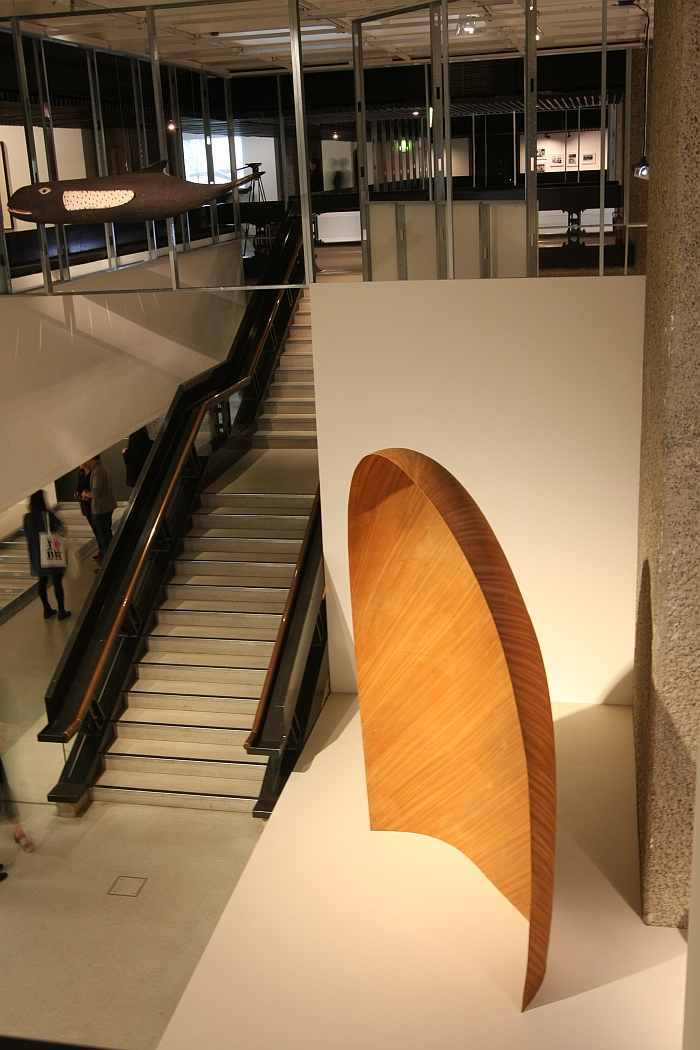"The World of Charles and Ray Eames"
It is inherent in the nature of America's most productive 20th century creatives that there is no "world" of Charles and Ray Eames; there are "worlds"
In their new Eames retrospective the Barbican Art Gallery London attempt to combine these worlds into a coherent, comprehensible universe.
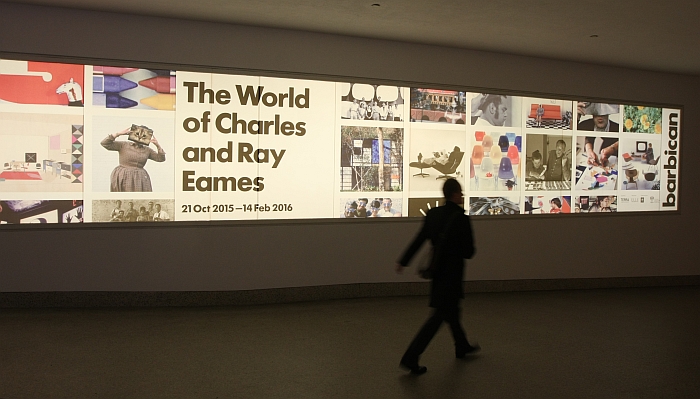
Charles Eames was born in St Louis, Missouri in 1907. Ray Kaiser in Sacramento, California in 1912. The pair met at Cranbrook Academy of Art in 1940, married in 1941, moved to California, established the design studio Eames Office in Los Angeles and revolutionised design. That is the, very, potted biography.
“Most people are aware of Charles and Ray Eames in context of furniture and other design objects”, says curator Catherine Ince, explaining the background to the exhibition, “however, the Eames Office had a prolific output across all types of different media and I think there is an awful lot about the practice of the Eames Office that still isn’t terribly well understood and we want to help more people understand and apprecate the breadth of what the Eames Office produced.”
The result is an exhibition which presents selected projects from across the pairs’ output, projects which stand as representative for the worlds in which Charles and Ray Eames moved: the toy world, the scenography world, the art world or publishing world, to name but four Eames’ worlds represented in snack size bites which are necessarily superficial yet in no way over-simplified, gratuitous or otherwise “light”.
We think we may have upset Catherine Ince in that we didn’t use the word “comprehensive” when she asked us what we thought of the exhibition. But it isn’t. Which isn’t a criticism. Presenting the worlds of Charles and Ray Eames comprehensively would require 5 Barbican Art Galleries. Per world.
Explaining the complete Eames oeuvre in one exhibition is an ambitious challenge, and one in which you invariably leave yourself open to criticism that this that or the other could have been done better. The World of Charles and Ray Eames is however a clear and concise presentation of the subject and is one which entertains and inspires as much as it informs and explains.
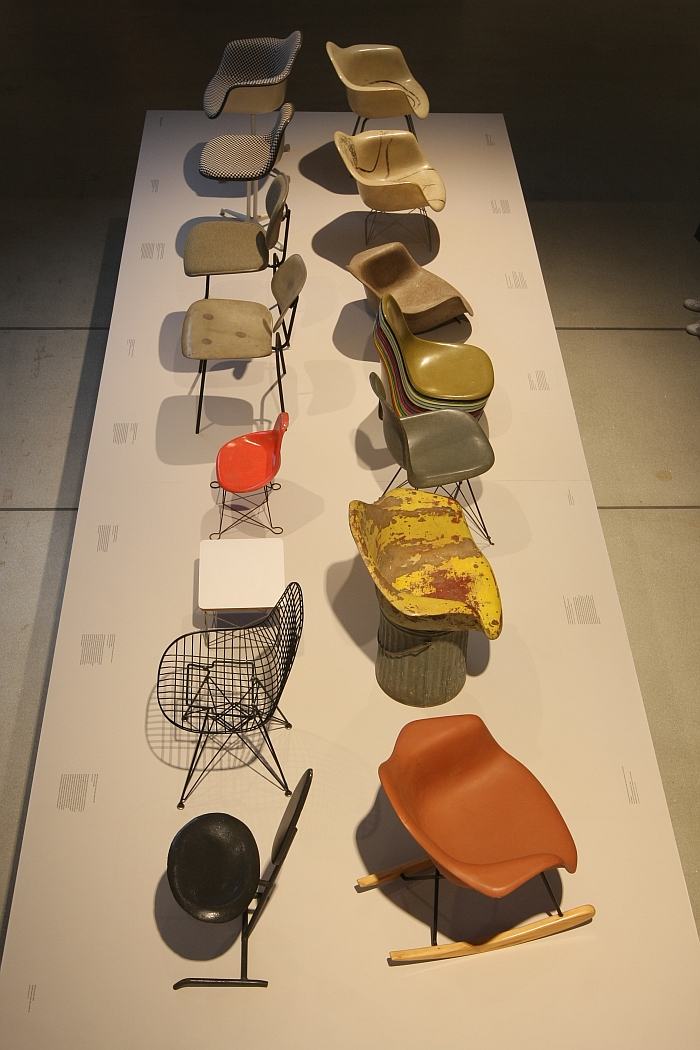
One of the central foci of the exhibition is, inevitably as it is correct, the furniture designs of Charles and Ray Eames. Separate sections presenting, for example, their moulded plywood and fibreglass chairs through a series of prototypes and realised pieces. And in these displays one sees the product of the (limited space) x (endless works) equation with which the curators had to work. For although there is a lot to view, to take in and to learn, including many insights and objects not to be found in the existing Eames literature, there has also been some very heavy editing and a lot of omissions and abridging. What there is is interesting, informative and presented in a fashion that although not particularly challenging, its all chairs on pedestals, is enjoyable. That may however just be us and the genuine joy we get from looking at chairs.
Viewing the chairs and other furniture objects we kept coming back to the fact that Charles and Ray Eames only designed furniture for Herman Miller, and subsequently Vitra following the transatlantic sharing of the licensees. While there were admittedly not that many contemporary furniture makers in America with whom they could have cooperated, there were options, and indeed Herman Miller Design Director George Nelson, was more than happy to work with numerous producers, but why did the Eamses' remain monogamous? "I think they simply liked the relationship with the companies" replies Charles Eames' grandson and current Eames Office director, Eames Demetrios, "even though Hermann Miller and Vitra were aware of the "design" label, their principle aim was to deliver quality products that worked and Charles and Ray Eames wanted to bring well designed products to as many people as possible, and so the two worked very well together. In addition there was also a common respect, for example, initially no-one thought the Lounge Chair would be a success but Herman Miller released it because they knew that Charles and Ray wouldn't deliver a product that wasn't well considered and founded on the best intentions."
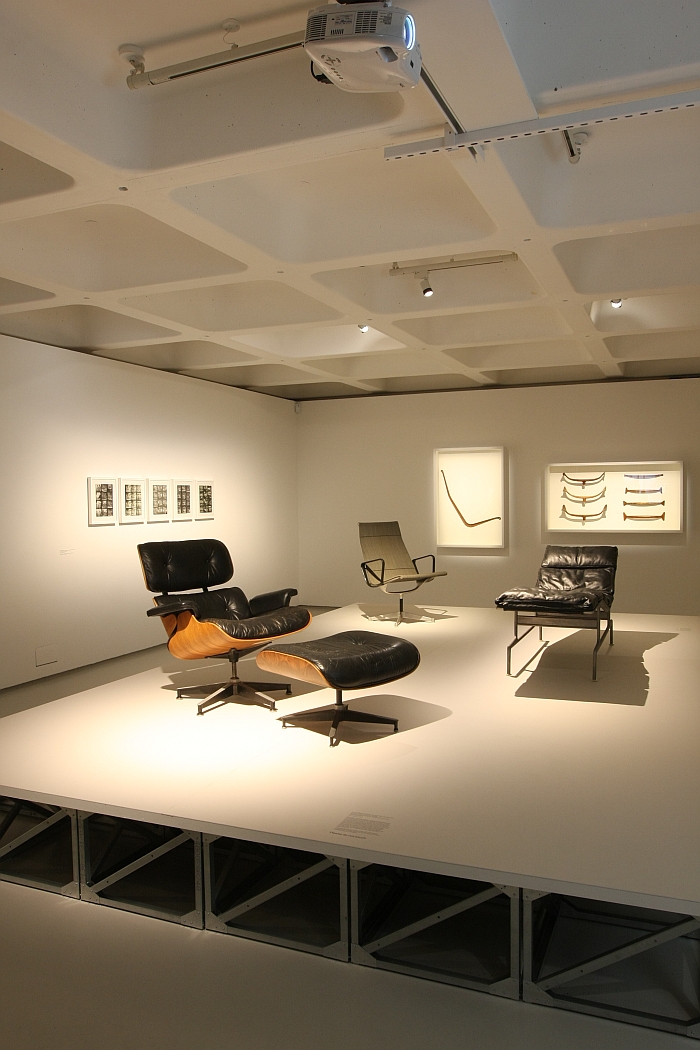
A further major focus of The World of Charles and Ray Eames is the exhibition worlds - both those Charles and Ray designed, and those in which their works were presented. Starting from Charles Eames' first solo exhibition at the New York Museum of Modern Art, MoMA, in 1946, museal presentations played an important role in establishing Charles and Ray Eames' reputation. For The World of Charles and Ray Eames the Barbican have recreated the showcase of their works the pair created for their contribution to the exhibition For Modern Living curated by Alexander Girard at the Detroit Institute of Arts in 1949: a showcase which beautifully demonstrates how powerful, convincing and thus commercially important, such exhibitions could be, and how effortlessly enduring the Eames' furniture designs are.
A much larger section is given over to those exhibitions Charles and Ray designed, for all their Information Machine pavilion for IBM at the 1964-65 New York Worlds Fair; a truly monstrous piece of work concerning itself with science, history, architecture and all that was important in and for the modern technology age. In addition the Information Machine is a nice example of how in their exhibitions and installations Charles and Ray Eames experimented with new presentation forms, with multi-media, interactivity and challenged accepted conventions, and thus helped advance ideas about exhibition design. A state of affairs which naturally poses the very obvious question of how much one is aware of your subject's status and influence when preparing an exhibition about people who created so many important exhibitions? "You do naturally reflect on such", replies Catherine Ince, "but with any contemporary reflection you have to find your own language and your own voice and it was important for me that it felt like a contemporary exhibition and not a nostalgic, retrospective in the sense of employing Eames' aesthetics"
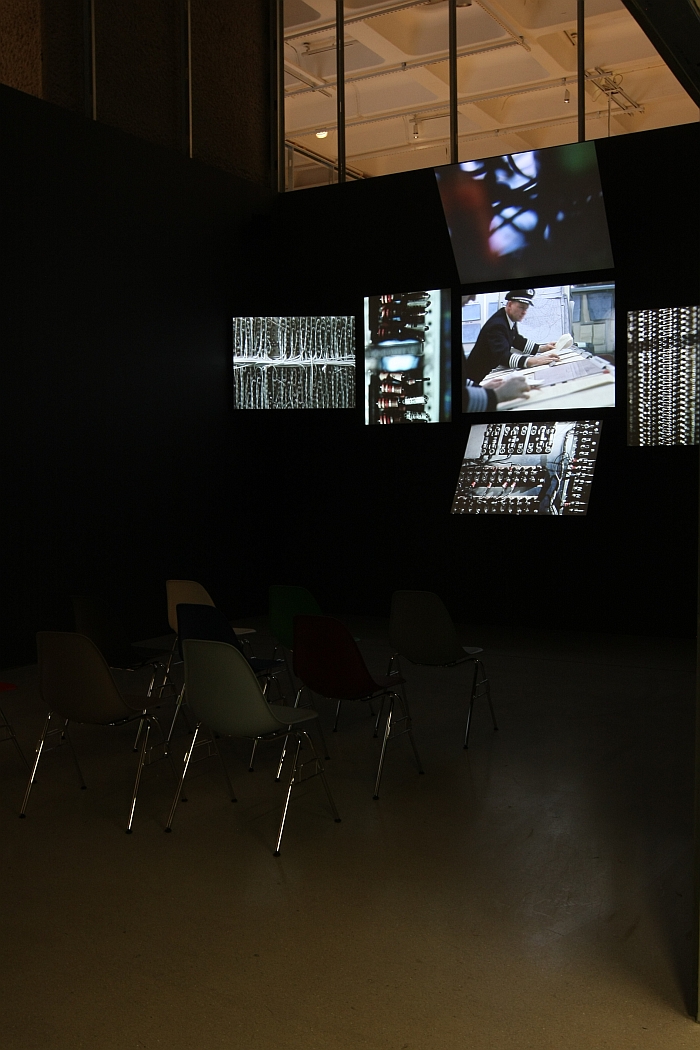
All encompassing as the Barbican's exhibition is, one can't help feeling that there is one world The World of Charles and Ray Eames doesn't explore sufficiently: the private world. Yes there is the absolutely delightful marriage proposal Charles Eames penned to Ray in 1941, but in terms of insights into the pairs characters, personalities, beliefs and backgrounds the exhibition is sadly wanting. Is that important? To paraphrase the narrator in Julian Barnes' novel Flaubert's Parrot, why do we need to know about artists backgrounds? Is their work not enough? "As a designer your attitude transfers to your work" answered Matylda Krzykowski a similar question in context of the Depot Basel exhibition Forum for an Attitude at the Vitra Design Museum. And it is an inescapable conclusion that understanding Charles and Ray Eames helps us understand their work. Or perhaps better put, helps us to understand their work better, and so helps us better understand the relationships and continuities that exist in and throughout their work. Yes, the exhibition does feature a very nice short film presenting the answers Charles Eames gave in response to questions posed by the Louvre ahead of the 1969 exhibition "What is design?", answers which provide an excellent insight into how he viewed design. But that is at best a start.
In the 1950s Charles Eames was invited to speak in London, and somewhat against his better judgement agreed to bring some images from inside the Eames Office - against his better judgement because, in the words of curator Catherine Ince, Charles Eames was of the opinion that "the blood should not be shown": one presents the end result, not how you got there. Ultimately Charles Eames brought a film of the Eames Office at work - a film shot through a kaleidoscope, nothing was visible except dancing patterns, yet he had kept his promise. That kaleidoscope film is playing at the entrance to The World Of Charles and Ray Eames and one can't help feeling that the Eamses' remain a designer duo largely viewed through a kaleidoscope, one with particularly bright and cheerful images. For our part we would genuinely wish a little more clarity on the subject. A little more blood.
We understand the exhibition catalogue contains one or the other text which reveal a little more; we however would have found it better if the exhibition had, for example, ignored the ubiquitous Lounge Chair and instead presented a little more Charles and Ray.
But as we say, tackling a theme such as The World of Charles and Ray Eames leaves you exposed to the naysayers.
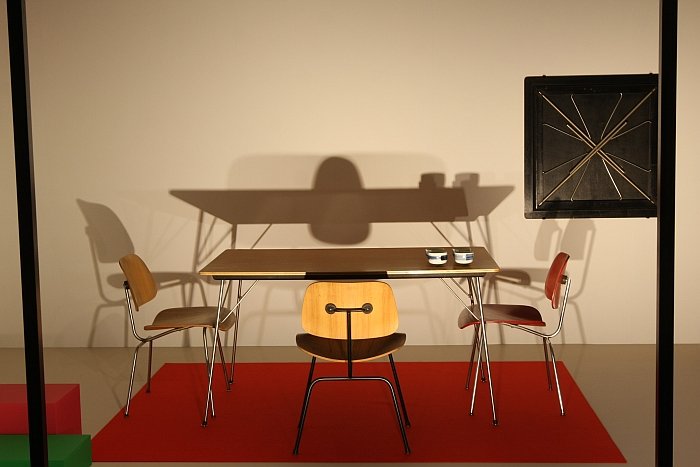
The Eames world, effectively, ended on August 21st 1978 with the death of Charles Eames. Although the Eames Office continued under Ray's guidance and small works were produced and existing contracts honoured, little new of note was produced. With Ray Eames death on August 21st 1988 the final chapter finally closed on the final Eames world.
A situation which of course raises questions about how a contemporary Eames world could, would look. Given the wide and varied interests and passions of the pair, given their general curiosity and zest for life, what if Charles and Ray had been operating today? Would they, for example, have embraced Open Design we ask Eames Demetrios, as a way to bring the best to the most for the least?
"One of the things with Charles and Ray is that they always wanted to maintain the quality, and have the quality as part of the experience, and that becomes harder to do in an Open Design format" he answers, crushing our illusions, "on the other hand one could argue that folk art is an Open Design format, they would have certainly understood Open Source and Open Design as part of a similar concept of uncontrolled control and so they would have definitely been intrigued by the developments and explored them, if not necessarily adopted them"
And the internet? That is surely a plaything made for Charles and Ray Eames?
"There is no question that they would have seen many possibilities, and the first thing they would have done is to play about a bit with it and look for ways to harness the medium", replies Eames Demetrios, buoying us up again, "they were for example responsible for some of the first interactive laser discs, back in the days when there were probably five laser disc players in existence, and they made a film called "Cable the Immediate Future" which anticipates much of the internet and which underscores that they totally saw the possibilities"
An answer which of course also highlights that there is no App to accompany the new exhibition. No QR codes to scan and thus no direct extension of the physical exhibition into the virtual world. Charles Eames we feel would have produced an App. In fact we know he would have. However, we're very glad there isn't one, for we doubt even the vastness of the internet is large enough to comprehensively capture and present the expansive terrain that is the Worlds of Charles and Ray Eames.
The World of Charles and Ray Eames is however a good place to start getting a sense of orientation and to find your bearings.
The World of Charles and Ray Eames runs at the Barbican Art Gallery, Silk St, London until Sunday February 14th
Full details, including information on the accompanying fringe programme, can be found at www.barbican.org.uk

